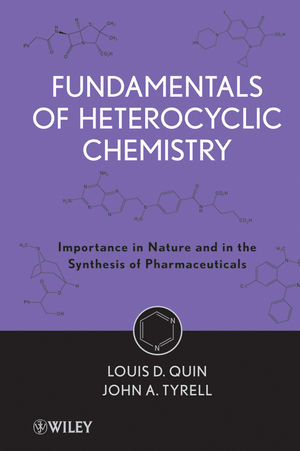|
Textbook
Fundamentals of Heterocyclic Chemistry: Importance in Nature and in the Synthesis of PharmaceuticalsISBN: 978-0-470-56669-5
Hardcover
344 pages
August 2010, ©2010
 This is a Print-on-Demand title. It will be printed specifically to fill your order. Please allow an additional 10-15 days delivery time. The book is not returnable.
|
||||||
ACKNOWLEDGMENT.
Chapter 1 THE SCOPE OF THE FIELD OF HETEROCYCLIC CHEMISTRY.
References.
Appendix.
Chapter 2 COMMON RING SYSTEMS AND THE NAMING OF HETEROCYCLIC COMPOUNDS.
2.1. General.
2.2. Naming Simple Monocyclic Compounds.
2.3. Handling the "Extra Hydrogen".
2.4. Substituted Monocyclic Compounds.
2.5. Rings With More Than One Heteroatom.
2.6. Bicyclic Compounds.
2.7. Multicyclic Systems.
2.8. The Replacement Nomenclature System.
2.9. Saturated Bridged Ring Systems.
References.
Review Exercises.
Chapter 3 NATURE AS A SOURCE OF HETEROCYCLIC COMPOUNDS.
3.1. General.
3.2. Naturally Occurring Nitrogen Heterocyclic Compounds.
3.3. Oxygen Compounds.
3.4. Sulfur and Phosphorus Heterocyclic Compounds in Nature.
References.
Chapter 4 PRINCIPLES OF SYNTHESIS OF AROMATIC HETEROCYCLES BY INTRAMOLECULAR CYCLIZATION.
4.1. General.
4.2. Some of the Classic Synthetic Methods.
4.3. Cyclizations Involving Metallic Complexes as Catalysts.
4.4. Cyclizations with Radical Intermediates.
4.5. Cyclizations by Intramolecular Wittig Reactions.
4.6. Synthesis of Heterocycles by the Alkene Metathesis Reaction.
References.
Review Exercises.
Chapter 5 SYNTHESIS OF HETEROCYCLIC SYSTEMS BY CYCLOADDITION REACTIONS.
5.1. The Diels–Alder Reaction.
5.2. Dipolar Cycloadditions.
5.3. [2 + 2] Cycloadditions.
References.
Review Exercises.
Chapter 6 AROMATICITY AND OTHER SPECIAL PROPERTIES OF HETEROCYCLES: PI-DEFICIENT RING SYSTEMS.
6.1. General.
6.2. Review of the Aromaticity of Benzene.
6.3. Pi-Deficient Aromatic Heterocycles.
References.
Review Exercises.
Chapter 7 AROMATICITY AND OTHER SPECIAL PROPERTIES OF HETEROCYCLES: PI-EXCESSIVE RING SYSTEMS AND MESOIONIC RING SYSTEMS.
7.1. Pi-Excessive Aromatic Heterocycles.
7.2. Mesoionic Heterocycles.
References.
Review Exercises.
Chapter 8 THE IMPORTANCE OF HETEROCYCLES IN MEDICINE.
8.1. General.
8.2. Historical.
8.3. Pyridines.
8.4. Indoles.
8.5. Quinolines.
8.6. Azepines.
8.7. Pyrimidines.
8.8. Concluding Remarks.
References.
Chapter 9 SYNTHETIC METHODS FOR SOME PROMINENT HETEROCYCLIC FAMILIES: EXAMPLES OF PHARMACEUTICALS SYNTHESIS.
9.1. Scope of the Chapter.
9.2. Pyrroles.
9.3. Furans.
9.4. Thiophenes.
9.5. 1,3-Thiazoles.
9.6. 1,3-Oxazoles.
9.7. Imidazoles.
9.8. Pyrazoles.
9.9. 1,2,4-Triazoles.
9.10. Tetrazoles.
9.11. 1,3,4-Thiadiazoles and other 5-Membered Systems.
9.12. Indole.
9.13. Pyridines.
9.14. Quinolines and Isoquinolines.
9.15. Benzodiazepines.
9.16. Pyrimidines.
9.17. Fused Pyrimidines: Purines and Pteridines.
9.18. 1,3,5-Triazines.
9.19. Multicyclic Compounds.
References.
Review Exercises.
Chapter 10 GEOMETRIC AND STEREOCHEMICAL ASPECTS OF NONAROMATIC HETEROCYCLES.
10.1. General.
10.2. Special Properties of Three-Membered Rings.
10.3. Closing Heterocyclic Rings: Baldwin’s Rules.
10.4. Conformations of Heterocyclic Rings.
10.5. Chirality Effects on Biological Properties of Heterocycles.
References.
Review Exercises.
Chapter 11 SYNTHETIC HETEROCYCLIC COMPOUNDS IN AGRICULTURAL AND OTHER APPLICATIONS.
11.1. Heterocyclic Agrochemicals.
11.2. Applications of Heterocyclic Compounds in Commercial Fields.
References.
Appendix UNIFIED AROMATICITY INDICES (IA) OF BIRD.
INDEX.



